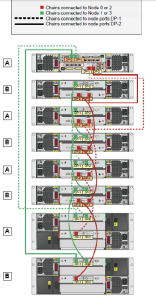Over the past few days I have been completing all the pre-upgrade host checks for the 3Par OS upgrade to ensure a successful upgrade. Here are the steps I’ve taken:
1 Check compatibility of components – This is to ensure that you are running a tested configuration of components that have been proven to work together by HP. There are 2 ways to go about this. Firstly you can use SPOCK. This site contains all the compatibility information you will need to complete your own checks. Or you can complete a host worksheet and return it to HP who will then verify the compatibility of all your components and firmware versions. The components you need to check are fairly standard to any SAN upgrade – Server OS, multipath software, HBA’s and fabric switch firmware versions.
In my case as this is the upgrade of our largest datacentre I did both. My checks matched up with HP’s with only once cluster requiring a HBA driver upgrade. This upgrade is done so onto the next stage
2 Check load balancing is set to round robin – This is a requirement for any Windows servers running 2008 and using the native MS MPIO driver. As I have over 40 hosts to check I didn’t want to have to visit this manually. So I managed to get a script to do it, here is how:
I used the Microsoft command line application mpclaim to view the multipath configuration. Specifically I ran mpclaim –s –d from the command line.
To run the command line on multiple servers remotely without having to logon I used psexec. You can download it from here . Here is an excellent article on how to use it: psexec guide
In this case I used it in the following way
A Choose the server you want to run the script from and create a folder on it called C:scripts. Copy psexec to this folder
B in C:scripts create a file called 3par_servers.txt. Populate this with a list of the servers you wish to check for multipath configuration
C Also in C:scripts create a batch fie called mpclaim.bat and enter the following command line into it mpclaim –s –d
D Finally, open a command line from the machine you wish to run the script on, change directory to C:scripts and then enter c:Scripts>psexec -c -f @C:scripts3par_servers.txt C:scriptsmpclaim.bat
E You should then see the window populate with the information you require. An example of the output is below:
\Server1
C:Windowssystem32>mpclaim -s -d
For more information about a particular disk, use ‘mpclaim -s -d #’ where # is the MPIO disk number.MPIO Disk System Disk LB Policy DSM Name
——————————————————————————-
MPIO Disk5 Disk 6 RR Microsoft DSM
MPIO Disk4 Disk 5 RR Microsoft DSM
MPIO Disk3 Disk 4 RR Microsoft DSM
MPIO Disk2 Disk 3 RR Microsoft DSM
MPIO Disk1 Disk 2 RR Microsoft DSM
Check LB policy appears as RR for all volumes.
3 Preventing LUN’s being marked as offline following reboot – On the first Windows Server 2012 or Windows Server 2008 reboot following an HP 3PAR array firmware upgrade (whether a major upgrade or an MU update within the same release family) the Windows server will mark the HP 3PAR LUNs offline but the data remains intact. To prevent this it is recommended that KB2849097 is applied to all attached Windows 2008/2012 hosts
It is essentially a PowerShell that changes the registry value to 0 for HKLMSystemCurrentControlSetEnumSCSI<device><instance>DeviceParametersPartmgr. The value is responsible for the state of HP 3PAR LUNs following an array firmware upgrade and a 0 indicates they stay online.
Windows Server 2008/2012 requires the PowerShell execution policy to be changed to RemoteSigned to allow execution of external scripts you can control this through a GPO. Or again amend through a PowerShell command
I got our PowerShell guy to look into if there was a way to the script against all hosts remotely but didn’t have much luck with this. It’s something I will have to look into for future upgrades, but on this occasion I had to log into each host individually and run the script.
So once you have ran the script in KB2849097 you can check its set the registry value as expected value by running: the PowerShell commands
Get-ItemProperty –path “HKLM:SYSTEMCurrentControlSetEnumSCSIDisk*Ven_3PARdata**Device ParametersPartmgr” -Name Attributes
The value returned should then be 0
4 VM’s on ESX running pass through disks. The following wasn’t relevant to our environment but if you are running ESX with raw device mappings check out KB2754704 and KB2821052
That’s it host checks complete! Onto the next stage
If you missed the first part of this series catch it here:
HP 3Par Upgrade Part 1 – Planning

